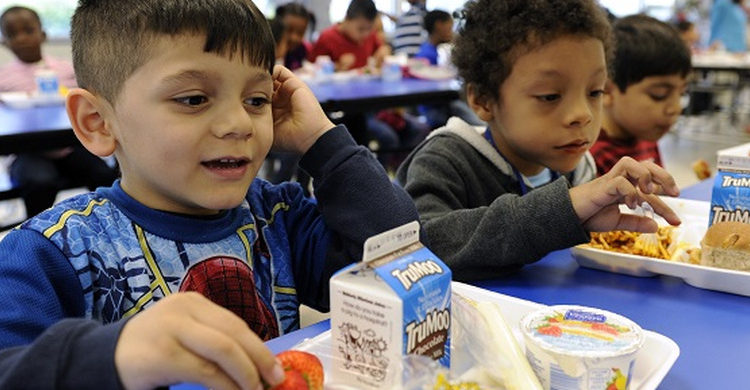América del Norte/EEUU/Abril 2016/Autor: Cory Herro/ Fuente: ThinkProgress
Resumen: Legisladores de la Cámara están luchando -en silencio- para hacer retroceder una parte de un proyecto de ley de nutrición escolar del 2010, que ofrece a los estudiantes en las escuelas de alta pobreza de almuerzos gratis. Si tiene éxito, lograrían recortes presupuestarios que reducirían, en gran medida, el número de escuelas elegibles para los programas de comida gratis o subvencionados.
House lawmakers are quietly fighting to roll back a section of a 2010 school nutrition bill that provides students in high-poverty schools with free lunches. If successful, their proposed cuts would greatly reduce the number of schools eligible for free or subsidized meal programs.
Although the 2010 bill survived budget cuts in January, thanks to the Senate’s support, the House Education and Workforce Committee is not as eager to see it through. The bill originally provided free lunches and after-school meals to every student enrolled in a public school where at least 40 percent of its study body lived in low-income households. Last week, lawmakers began pushing to only allow schools this privilege if they have a majority of their students living at or near the poverty line — 60 percent. For a family of four, that would mean making less than $31,000 per year.
This battled provision, called “community eligibility” for free lunches, has been applauded by lawmakers and advocates for eliminating school meal applications and the stigmatized free-lunch line. It helps under-resourced schools save time and administrative work — “[shifting] resources from paperwork to higher-quality meals or other educational priorities,” according to Zoë Neuberger of the Center on Budget and Policy Priorities (CBPP).
Without it, Neuberger said these already under-resourced schools in high-poverty communities would be additionally burdened with more paperwork and administrative work. Plus, she argued, community eligibility programs don’t just benefit the children who are dubbed “low income.” According to a 2014 study by the CBPP, “high-poverty neighborhoods, which can be violent, stressful, and environmentally hazardous, can impair children’s cognitive development, school performance, mental health, and long-term physical health — even if the family itself is not low-income.”
If passed, the new standard would revoke eligibility for 7,022 schools serving 3.4 million students. Additionally, another 11,647 schools that qualify for community eligibility, but have not yet adopted it, would lose eligibility, the Center on Budget and Policy Priorities found.
Within two years, students at these schools would have to go back to applying for free lunches and proving their eligibility in lunch lines — a delay-fraught process that leaves schools heavy with paperwork and students emotionally vulnerable.
When Congress passed Healthy Hunger-Free Kids Act in 2010, it focused primarily on reducing levels of obesity, diabetes, and heart disease — side effects of the bill’s leading target: poverty. The legislation not only improved nutritional standards for school lunches, requiring more fruits, vegetables, and whole grains — it boosted funding for free and reduced-price lunch programs and after-school programs.
The Act improved school nutrition for more than 31 million students nationwide, half of whom live in low income households and qualify for free and reduced-price lunches. For many of these students, free lunches are their only reliable source of food during the week.
House Education and Workforce Committee members defended the new standard, saying it would save taxpayer dollars. “The reforms in this legislation will allow states and schools to better serve their students and families, while also ensuring taxpayer dollars are spent effectively and responsibly,” Rep. John Kline (R) said in a press release.
Rep. Todd Rotika (R) added that the bill would «fight fraud, waste, and abuse.»
Critics say the 40 percent threshold isn’t wasteful, but properly identifies schools in need. «[In] schools with such high concentrations of poverty, students who don’t qualify for free or reduced-price meals are typically not much better off than those who do qualify,» wrote Neuberger.
The money spent is an investment in children’s academic performances, said Margaret Allen, superintendent of Montgomery, Alabama schools, where a quarter of children live in poverty.
«Many of our families live below the poverty line,” she told the Montgomery Advertiser in 2014. “Even those that don’t may skip meals to save money. [Universal free lunches] will ensure learning won’t suffer because a student is hungry at school.»
Fuente de la noticia: http://readersupportednews.org/news-section2/318-66/36587-house-republicans-want-to-cut-free-school-lunch-programs
Fuente de la imagen: hhttp://readersupportednews.org/images/stories/article_imgs20/020829-kids-042916.jpg







 Users Today : 31
Users Today : 31 Total Users : 35460523
Total Users : 35460523 Views Today : 74
Views Today : 74 Total views : 3419432
Total views : 3419432